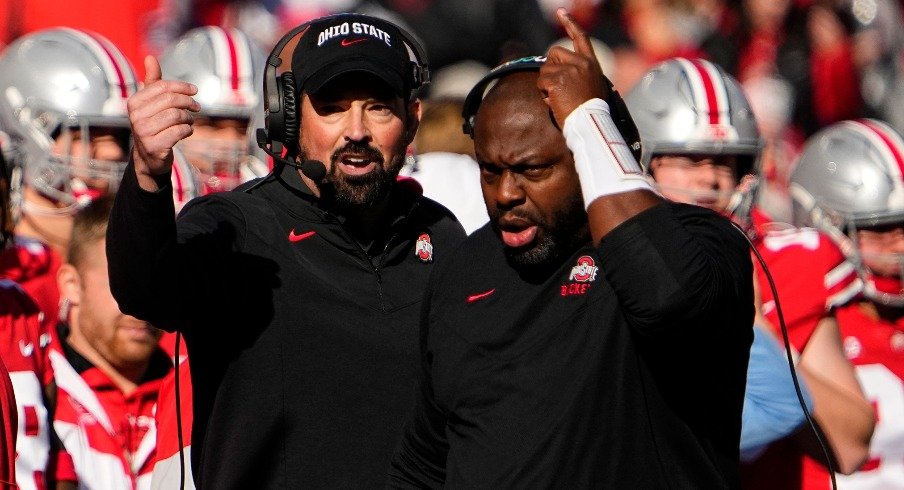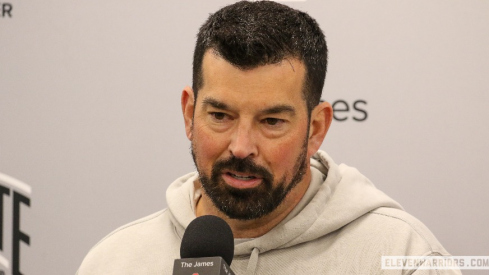The Ohio State offense hasn’t been the same since the bye week.
Sure, the Buckeyes showed glimpses of the Death Star-level destruction that struck fear in the hearts of opposing defensive coordinators during the final six games of the regular season. But not for sustained stretches week-to-week like it did to kick off the 2022 campaign.
Throw out any analytics and the eye test would echo that sentiment. But I’m not here to discuss what it seemed like the difference was in Ohio State’s offensive performance. If you’ve been searching for a stat to confirm the Buckeyes’ decline over the ladder half of the year, look no further.
Ohio State scored 25.2% fewer touchdowns on its offensive possessions in the final six games than it in the first six. Despite having nine more drives after the bye week, the Buckeyes scored 15 more touchdowns in the first six contests. Before Iowa, Ohio State got in the end zone on 41 of its 71 offensive possessions, a conversion rate of 57.7%. Iowa and after, that number shrank to 26 touchdowns on 80 drives, for just 32.5%.
| STAT | FIRST 6 GAMES | LAST 6 GAMES |
|---|---|---|
| TD/DRIVES (%) | 41/71 (57.7%) | 26/80 (32.5%) |
| TOTAL YPG | 543.7 | 441.7 |
| PASSING YPG | 315.7 | 272.7 |
| PASSING TD | 25 | 13 |
| RUSHING YPG | 228 | 169 |
| RUSHING TD | 16 | 13 |
When Ohio State hit its stride in the first half of the season, it felt like it broke the plane every time the offense touched the ball. That’s because, for long periods of time in several games, it did. Ohio State had six stretches where it scored touchdowns on at least three consecutive possessions in the first six games.
The Buckeyes scored seven straight touchdowns to open the Toledo game. Then, after a punt, it scored four more consecutively. OK, OK, that was Toledo. But how about the very next week against Wisconsin, when Ohio State opened the game with four straight touchdowns? Against Rutgers, the Buckeyes scored three straight touchdowns in two different stretches, and Ohio State might have had eight in a row against Michigan State if not for a C.J. Stroud interception on the second drive.
In the final six games, Ohio State only had three stretches of three straight touchdowns or more, and only one in the last four games. In the Michigan loss, the Buckeyes couldn’t even string two straight touchdowns together and ultimately scored just three points in the second half.
The Buckeyes’ slow start against Iowa was the first warning sign. In that contest, Ohio State only scored one touchdown on its first 10 drives. Given the week off that preceded the game and the fact that the Buckeyes still finished with 54 points, it was an easy performance to overlook. Especially when coupled with the fact that Iowa’s defense was the best Ohio State had seen up to that point.
But it wasn’t much better to start out against Penn State. In Happy Valley, the Buckeyes only scored one touchdown on the first nine drives. Ohio State bounced back to score three straight offensive touchdowns in the fourth quarter, though, and wound up with a come-from-behind win over the No. 10 team in the country. Again, Ohio State got a pass.
The worst showing of all came the next week, when the Buckeyes mustered just 21 points in a 14-point win against Northwestern. Ohio State went six straight drives without a touchdown to open the game, and even trailed to the worst team in the conference at halftime. This time it was the weather that served as the prevailing excuse for the Buckeyes. It was valid enough, given wind gusts upwards of 40 miles per hour and pouring rain in Evanston.
Ohio State more or less resembled its pre-bye week form against Indiana and pieced together enough offense to put up 44 in a tight win on the road at Maryland. But when faced with the No. 1 total defense in the nation in the most important game of the season, the Buckeyes couldn’t snap back into the lethal unit that ran roughshod over opponents drive after drive.
Far from unstoppable by the end of The Game, Ohio State didn’t even inspire much confidence in its ability to come back from an eight-point deficit with 7:23 on the clock. It didn’t, of course, and the Buckeyes failed to score a touchdown at all in the second half. Big plays from the Michigan offense might have doomed it anyway, but Ohio State’s offense was supposed to be its calling card. Instead, it mustered just three points in the final 30 minutes before the Wolverines planted their flag at the 50-yard-line.
Flag planted. pic.twitter.com/vBHd0ICliQ
— Jordan Strack (@JordanStrack) November 26, 2022
There are plenty of reasons for the general trend, beyond the ones I gave game-by-game down the stretch. For one, Ohio State faced higher-caliber defenses in the second half of the season than it did in the first. Only two of the Buckeyes’ first six opponents have top-50 scoring defenses after 12 games (Notre Dame and Wisconsin), with the Badgers holding the highest rank at No. 25. Ohio State faced three top-10 scoring defenses in the second half of the season alone, as Michigan (No. 3), Iowa (No. 6) and Penn State (No. 10) have all held opponents to 18 points or under on average in 2022.
Still, Indiana (No. 120) and Northwestern (No. 84) are two of the four worst scoring defenses Ohio State played all season, and both games came in the final six regular-season contests.
The injury bug bit Ohio State after the bye week as well, and perhaps we won’t know the full extent to which it impacted the Buckeyes until after the season – if ever. What we do know it that the Ohio State running back room was held together with Scotch tape over the final six games, with TreVeyon Henderson and Miyan Williams trading off ailments the whole way.
| PLAYER | FIRST 6 GAMES | LAST 6 GAMES |
|---|---|---|
| Treveyon Henderson | 69 ATT, 436 YDs, 4 TDs | 61 ATT, 320 YDs, 5 TDs |
| Miyan Williams | 64 ATT, 497 YDs, 8 TDs | 38 ATT, 135 YDs, 2 TDs |
Ohio State’s top two running backs took a combined 133 attempts for 933 yards and 12 rushing scores in the first six games. In the last six, they had 99 carries for 455 yards and seven scores. With Williams out against Maryland and Henderson sidelined last weekend, the pair had just 19 carries for 53 yards and no touchdowns in total in the last two games.
And the passing game? The drop-off was evident in that department as well. Of his 37 passing scores this season, Stroud threw only 13 in the last six games. Stroud also averaged 22.3 fewer yards per game after the bye and completed 8% less of his pass attempts.
On the whole, Ohio State averaged over 100 fewer yards of total offense per game after the bye (441.7) than it had before (543.7).
All of that resulted in only one loss for Ohio State, but it was one that will haunt the program for the foreseeable future. And if you paid attention to the warning signs along the way, perhaps Saturday’s measly effort on offense might not have been a wholesale surprise after all.


